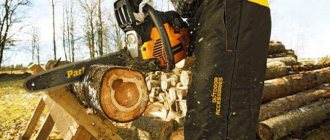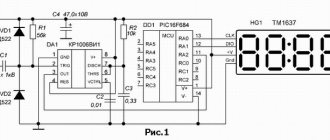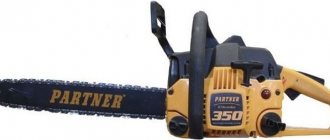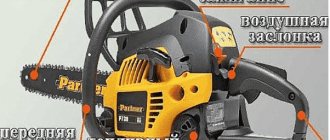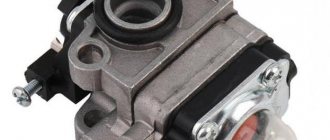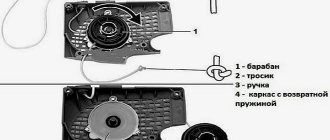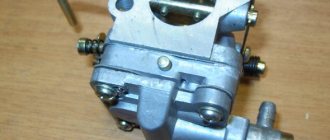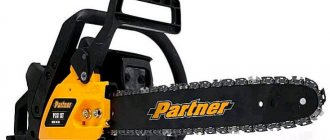A chainsaw is an indispensable and reliable assistant in every household. The ease of use of the tool makes it even more popular, but the occurrence of various types of malfunctions can never be ruled out. If various types of chainsaw malfunctions occur, then to eliminate them you will need to resort to repair measures. You can repair a chainsaw yourself, but first you need to determine the malfunction. The material will discuss not only all kinds of malfunctions, but also the features of their elimination.
Engine repair
The design of all chainsaw models is similar. The main unit of any chainsaw is a two-stroke internal combustion engine, the functioning of which drives the cutting element - the saw chain. A starter is used to start the engine, and a carburetor is used to regulate the supply of fuel and mix it with air. In order to increase the efficiency and productivity of the tool, the chain and bar are lubricated during its operation. This is a separate system, the failure of which can lead to a number of negative consequences. Any element can fail, which will result in the impossibility of further use for the operation of the tool.
When malfunctions occur, questions often arise such as how to repair a chainsaw, and what is needed for this? Initially, it is necessary to identify the cause of the breakdown, and only after that make an appropriate decision to eliminate it. If the chainsaw does not start, this most often occurs as a result of a carburetor malfunction. Rarely, the cause may be a faulty starter or the inexperience of the person trying to start it. Let's consider the main types of malfunctions of various systems, as well as the features of their independent elimination.
Chainsaw starter repair
Every 10-year-old boy knows what a starter is intended for, so it makes no sense to consider the purpose of this device. It must be said that chainsaws use the simplest type of manual starter, which allows you to start a two-stroke engine by pulling the handle, which is connected via a cable to the clutch drum. A number of starter malfunctions include:
- pulley damage;
- spring damage;
- cable break.
If the pulley is damaged, it should be replaced with a new one. If the spring is damaged where it engages with the groove of the drum, then you can try to repair it, although in most cases it is not worth it, it is only relevant if you are far from civilization. If the cable breaks, it must be replaced, which will require removing the starter cover and carefully replacing it. It is not advisable to take a chainsaw in for repair if the starter is faulty, since it will be much cheaper to carry out independent repairs or replacement.
Fuel supply system
The following types of malfunctions are distinguished in the fuel supply system:
- fuel filter clogged;
- clogging of the hole in the tank lid;
- supply of a small amount of fuel.
You can also fix these problems yourself. The first step is to disconnect the fuel hose and make sure that fuel is flowing from it. If fuel does not flow out, then you need to clean the hole in the cap with a needle. You should also replace the fuel filter, which is recommended every 3 months. If an insufficient amount of fuel flows from the carburetor into the cylinder, the cause may be an imbalanced fuel-to-air ratio in the carburetor. You will need to adjust the carburetor, which you can also do yourself. When the fuel mixture comes from the carburetor in large quantities, it is necessary to clean and adjust the carburetor.
It is important to know! Carburetor repairs should be entrusted to specialists or such work should only be undertaken if you have the appropriate experience.
Chainsaw ignition unit repair
If the ignition system malfunctions, you can repair this unit yourself. The malfunction of this system should begin to be looked for directly by inspecting the spark plug. The presence of moisture on the contact group indicates an excess of fuel. This means you need to adjust the carburetor.
It is important to know! Spark plug moisture may occur due to prolonged running of the tool.
If there is carbon deposits, it is necessary to clean the electrodes with fine sandpaper (zero sandpaper). The cause of soot is often an incorrect ratio of gasoline and oil. A spark test needs to be performed. If a spark does not appear, the spark plug must be replaced. Replacement is recommended depending on technical requirements. Fixing faults in the ignition system does not require special skills, so you can resort to removing them yourself.
Piston group repair
If you suspect a malfunction of the cylinder-piston group (CPG), it is necessary to check its condition. In order not to disassemble the mechanism, just unscrew the muffler and look through its window. You can check the performance of the piston and crank mechanism by measuring compression. The compression gauge is installed in the spark plug hole, after which it is necessary to turn the crankshaft with the starter. The optimal compression value for normal engine operation is a value of at least 0.8-0.9 MPa. Measuring compression allows you to determine the wear of the piston rings, and then replace them if necessary.
Disassembling and cleaning the muffler
A clogged chainsaw muffler is one of the reasons for incorrect engine operation, as well as a decrease in its power. You can correct the situation yourself by dismantling the muffler and washing it using special detergents.
It is important to know! Dry cleaning of the muffler is not recommended, as carbon deposits contain carcinogens that can enter the lungs.
After removing the carbon deposits, it is necessary to thoroughly dry the muffler, and only then install it in place. The accelerated appearance of carbon deposits in the muffler may occur due to an incorrect ratio of gasoline and oil or due to the use of low-quality oil.
Drive problems
If the malfunction is a malfunction of the tool chain, then you can also fix it yourself, or replace it with a new one.
Chainsaw clutch repair
The clutch or clutch on the tool is presented in the form of a centrifugal drum, which is activated automatically. Over time, the clutch wears out, which leads to the need to replace it. The cause of clutch failure is wear on the drive sprocket teeth. If the coupling is solid with a crown or drive sprocket of the tool, then it must be replaced as a whole. If the sprocket is separated from the drum, then only the crown can be replaced, which will be much cheaper. The clutch requires only periodic lubrication, which extends its service life.
Principle of operation
The main unit of the system is the pump. The principle of its operation is the following. As the engine speed increases, a gear mounted on the main shaft drives the pump shaft through a worm gear. In turn, the rotation of the shaft creates a certain pressure in the oil line, which forces the oil to move along it towards the tire.
The end of the oil channel is located at the point of contact of the tire with the tool housing, where there is a longitudinal groove into which, when installing the tire, its oil channel falls.
The groove is needed to ensure the supply of oil to the bar, regardless of the degree of tension of the chainsaw chain. Simply put, no matter what position the tire is in at the time of operation, oil will get onto it through the groove.
Next, a chain is inserted into the lubrication process, on the links of which, depending on the chain model, there is either a groove or a hole through which the oil is dispersed throughout the tire. As the engine speed increases, the oil flow rate also increases.
Some models of chainsaws are equipped with pumps that additionally have adjustable flow capacity, and if necessary, the amount of oil supplied by the lubrication system can be increased or decreased.
This function is quite convenient, because it allows you to save and not waste excess oil.
Partner 370
Partner brand chainsaw is widely used for preparing boards for future repairs and construction.
Technical characteristics of the Partner 370 chainsaw
| Engine capacity | 34 cm 3 |
| Power | 1.4 l. s./1.8 kW |
| Recommended tire size | 35 cm |
| Saw chain pitch | 3/8 “ |
| Fuel tank volume | 400 ml |
| Lubricant tank capacity | 300 ml |
This lightweight chainsaw comes equipped with a high-quality automatic lubricant dispersal system and an effective inertia brake.
How to refuel a Partner chainsaw?
As the summary shows, to refuel the Partner you should use gasoline of at least AI-92 grade. It must be combined with oil designed for the operation of 2-stroke engines.
The average ratio of gasoline to oil for a Partner chainsaw is 50:1, in other words, 20 ml oil
Partner P350XT
Having excellent technical properties, this Partner household chainsaw is intensively used by beginners and experienced gardeners.
READ Chainsaw Starts and Stalls
Technical characteristics of the Partner P350XT chainsaw
| Engine capacity | 36 cm 3 |
| Power | 1.9 l. s./1.4 kW |
| Recommended tire size | 35 cm |
| Saw chain pitch | 3/8 “ |
| Fuel supply tank volume | 400 ml |
| Oil tank capacity | 200 ml |
This Partner chainsaw is built with long lasting parts that are of the highest quality and impressive reliability.
How to replace the oil pump on a Partner chainsaw?
If you find that the chain on your Partner chainsaw does not spin, then the cause of this problem most likely lies in the wear or breakdown of a separate pump designed to pump lubricant to the chain. The design of the oil pump includes 2 elements - a storage chamber and a working part. Repairing the pump involves disassembling the mechanism, but it is not recommended to take any actions with its working part. The next steps are as follows:
- Carefully inspect the inlet and outlet tubes through which the lubricant passes - as a rule, all pump malfunctions are associated with them;
- If the channels are clogged, then all debris must be removed. simultaneously blowing them with compressed air;
- If cracks appear on the channels, they need to be replaced;
If, after assembling the Partner , the lubricant again does not pass to the saw chain, the pump will need to be completely replaced.
Structural components of a chainsaw
All chainsaws are similar in structure, regardless of whether they are made in Europe (ECHO, Stihl, Husqvarna) or domestic (Kedr, Ural). Inside the body there are the main elements - the fuel tank and the engine, and outside there is a starter, a handle, a saw part (tire) with a chain. A sharp tug of the cable starts the engine, and it starts the saw blade.
To begin with, we invite you to familiarize yourself with videos that show how a chainsaw works and how it works:
From time to time, malfunctions occur in the operation of the saw, which require disassembly to eliminate. What can happen to such a simple mechanism as a chainsaw? At least the following:
- Stops starting;
- It starts, but soon stops;
- Stops functioning when cutting;
- Loses its power;
Most problems are associated either with interruptions in engine operation (fuel supply system, exhaust system, ignition, cylinder-piston part), or with malfunctions of other systems and components (clutch, chain brake, tire, lubrication system). Let's look at the most common breakdowns and methods for eliminating them.
A serviceable chainsaw starts with one pull and does not fail to cut
Recommendations in case of breakdown
Unfortunately, nowadays nothing is endless, and therefore our “good helper” - the chainsaw is no exception. In this small article we would like to look at an example of a breakdown on a “ Partner 350” chainsaw. This type of gas powered tool is very easy to use, is of good quality and will be affordable for many. This amazing chainsaw has a 1.8 horsepower engine. It helps perfectly with housework, has low operating noise and is not particularly large in size. But even such a saw needs repairs from time to time.
So, what should you do if suddenly your chainsaw breaks down? In most cases, people try to find information on the Internet. To do this, just type into the search line “chainsaw repair “Partner 350”. And you probably have already done that.
First, let's try to find what's wrong with our saw. It may not start, or it may start and immediately stall, or the chainsaw may simply lose its power. Yes, without abilities and experience it will definitely be difficult for you to do something here, but if you read this article, then with due diligence you will succeed.
The Partner chainsaw DOES NOT SUPPLY OIL TO THE CHAIN!!!
Checking the ignition system
The first thing you need to do if your chainsaw breaks down is to inspect the spark plug by disconnecting the wire and carefully unscrewing it with a special wrench.
Components of the chainsaw ignition system: 1 – flywheel with magnets, 2 – ignition module, 3 – spark plug, 4 – high voltage wire
The spark plug is unscrewed to check its condition
Her appearance speaks volumes:
- Dry. Most likely, the fuel mixture is not getting into the cylinder. The problem is not in the ignition system, so the spark plug is screwed back in.
- Heavily splashed with fuel. The reason for the excess fuel mixture lies either in violation of the starting rules or in incorrect carburetor adjustment. The spark plug is thoroughly wiped, the fuel supply is turned off and the starter is turned on to remove excess fuel and ventilate the combustion chamber. Then the candle is placed in place and the mechanism is started again.
- Covered with black soot. This may indicate the use of low-quality oil, an incorrectly adjusted carburetor, or an incorrectly calculated ratio of gasoline to oil. The spark plug should be washed, removed from carbon deposits with a sharp object (an awl or a needle), the electrodes should be wiped with sandpaper and placed in place.
When checking the spark plug, you need to pay attention to the gap between the electrodes: 0.5 to 0.65 mm is considered normal. A damaged or worn gasket must be replaced.
A large amount of black carbon deposits on the spark plug indicates problems with the engine.
To be completely sure, you should also check for a spark. To do this, put the ignition cable on the spark plug, connect the spark plug nut and the cylinder with pliers, turn on the starter and watch for the appearance of a spark. If it is missing, the spark plug needs to be replaced. If the new spark plug also does not produce a spark, the problem is in the high-voltage wire or in a broken connection to the spark plug.
Specifications
According to its data, Partner 350 belongs to the household (amateur) type and fully satisfies the needs of any consumer. To get a general overview of the chainsaw, just look at its main characteristics.
Characteristics of Partner 350
For those familiar with chainsaws, one glance is enough to determine the character of the 350 Partner. A fairly powerful engine and a decent length of tires mean that this will be an indispensable assistant on the farm, but it’s hardly suitable for professional felling.
Engine won't start
In this case, it is necessary to check the gap between the spark plug electrodes. It should be 0.5 mm. At the same time, the electrodes need to be cleaned of carbon deposits. In most cases, this is enough to get the engine running again. Starting is also affected by contamination of the carburetor, fuel and air filters. After washing them, the engine, as a rule, stops being capricious. On the pages of the site and the Internet there are many photos and videos on restoring engine performance.
Fuel supply system repair
Fuel may not enter the cylinder for the following reasons:
- Fuel filter is dirty. You should remove the fuel hose and check how the fuel flows. If the stream is weak, the filter may need to be cleaned. It is taken out through the filler hole of the fuel tank and cleaned; in case of severe contamination, it is replaced with a new one. As a preventative measure, it is recommended to replace the fuel filter once every three months.
- Clogged breather (hole in the fuel tank cap). They also check by disconnecting the hose; if clogged, clean it with a needle.
- Lack or insufficient fuel. There may be several reasons for the malfunction. The first reason is a clogged air filter. Air stops flowing into the carburetor in the required quantity, and therefore, due to the fuel mixture being too rich, engine operation is disrupted. The dirty filter is carefully removed, cleaned and rinsed in water, then dried and replaced.
Another reason is incorrect carburetor adjustment. Adjustment is made with three screws.
Timely replacement of the fuel filter guarantees a complete fuel supply
The fuel hose and choke actuator must fit tightly to the fittings
The throttle cable must be in place.
During work, you must use the instructions, otherwise you can only make things worse.
Related Posts
Proper disassembly of a chainsaw
- Technological process of repairing a Shtil chainsaw
- Engine repair, ignition
- Chainsaw disassembly sequence
Disassembling a chainsaw is a very important moment that occurs at some point for the owners of such a tool. Owners of chainsaws have to carry out technical maintenance on their own. How to disassemble a chainsaw quickly and accurately?
Regular maintenance of your chainsaw will make working with it comfortable and safe.
In order for the chainsaw to work flawlessly, it is necessary to carry out frequent maintenance, consisting of several operations:
- oil change;
- topping up fuel;
- adjusting chain tension;
- cleaning dirt under the lid;
- chain brake inspection and repair;
- cleaning the oil supply system;
- tire cleaning;
- cleaning or replacing the filter.
Chainsaw diagram "Calm".
The time comes and all these operations must be completed. Therefore, you need to learn how to quickly and correctly disassemble chainsaws.
The Shtil chainsaw has long been loved by lumberjacks due to its low cost. It can be seen in the hands of summer residents, and city services do not refuse such a chainsaw.
However, among the many positive qualities of this model, there is one serious drawback. How to remove a magneto from a chainsaw - www.fassen.net. Chainsaws break down very often. Moreover, not every malfunction will be repaired in accordance with the warranty. How to remove the carburetor from a husqvarna chainsaw. You have to do the repairs yourself.
To do this you must have:
Disassembling and cleaning the muffler
If the engine runs great at low speeds, but starts to stall at high speeds, the reason may lie in the muffler spark arrester, which is clogged with combustion products.
- remove the muffler;
- disassemble (there are also non-dismountable models);
- remove carbon deposits using detergents;
- dry with a hairdryer;
- install in place.
Dry cleaning is unacceptable, as carbon deposits contain carcinogens, the inhalation of which is hazardous to health. After removing the muffler, cover the exhaust hole with a clean rag.
Interruptions in the operation of the chainsaw indicate a possible clogging of the muffler
To prevent clogging of the muffler, it is necessary to monitor the composition of the fuel mixture. The amount of oil should not exceed the standards recommended by the manufacturer. Poor oil quality also negatively affects engine performance.
Device
The general arrangement is made in a traditional style. It is distinguished by its simplicity, which means high reliability of the unit.
Partner 350 chainsaw device
The diagram of the general structure of the Partner 350 chainsaw clearly confirms this.
Starting the engine is simple and reliable. This was made possible thanks to the presence of electronic ignition. The primer (fuel booster pump) plays a major role during startup.
The air filter is equipped with a double air purification system. As a result of equipping the starter drum with an impeller, large debris particles do not reach the filter at all. Thanks to this, its service life increases, and the degree of air purification increases. In general, this has a beneficial effect on engine performance.
Safe handling of a running saw is achieved by the presence of a chain brake operating in two modes - manual and automatic.
The oil pump only turns on while sawing. This means that the chain lubrication system operates automatically. It must be borne in mind that different types of oils are used to lubricate the chain and prepare the working mixture. find out what oil is used for the Partner 350 chainsaw
Saw chains. The Partner 350 saw is equipped with an Oregon 91P052E 3/8″ 1.3 mm 52 link chain. Replacement with analogues is acceptable: STIHL 39970000052с and others. For example, Husqvarna 5776151-22. Pay attention to the fact that with a chain pitch of 3/8″ and a groove width of 1.3 mm, the number of links does not exceed 52. Less (46 – 50) is possible, more is not advisable.
The anti-vibration system on the Partner 350 is somewhat harsh. Considering that this saw is not intended for professional use, the system as a whole can be considered satisfactory. By the way, significant improvements have been made in this regard on subsequent models.
Recommended components, parts, mechanisms and fuels and lubricants cannot be replaced with analogues.
Assessment of the condition of the cylinder-piston group
Often the engine does not start or does not operate at full capacity due to low pressure in the cylinder. It can be caused by wear of the piston or cylinder, stuck piston rings, or worn bearings. You can partially examine the condition of the cylinder-piston group (CPG) by removing the muffler and looking into the opened hole.
A compression gauge placed in the spark plug hole will help measure the compression in the engine - based on the measurement results, we can also talk about the condition of the CPG. Accurate data is obtained only after complete disassembly of the mechanism. If the piston is chipped or scratched, it needs to be replaced. The piston ring must be clean, free of carbon deposits, and be exactly in place.
Wear of the piston and crank mechanism is considered a serious problem
Based on the results of compression measurements, one can judge the condition of the CPG parts
Adjusting the chain brake
The chain brake often does not work due to grease or sawdust clogging the brake band and the space under the cover. All parts should be cleared of blockages. Perhaps the tape is simply worn out, then it needs to be replaced.
The operation of the chain brake is restored by mechanical cleaning
Some parts of a chainsaw wear out faster than others. These include the drive sprocket, tire, chain, and anti-vibration elements. For quick replacement, it is better to always have spare parts on hand. Don't neglect sharpening the chain.
A chainsaw is a simple device that, with proper care, can last a long time. At the same time, the saw is a tool subject to various loads and, therefore, breakdowns still occur. You will learn about what caused a certain malfunction and how to fix it from this article.
see also
Comments 62
You need to dismantle the tank, change the gasket and put it back together. You won’t be able to buy a gasket, so you’ll have to cut it out using the old one! What’s also interesting is that in most of these saws, the tank is joined without any gaskets at all. There the plastic is inserted quite tightly into each other. Well, with little blood, just work it a little, the old gasket will swell and the leak will go away!
It’s about the same saw, I use it only in the summer, I clean it for the winter and put it in a box on the balcony, fill it with gasoline in the spring - it leaks, and from somewhere in the middle of the saw - I don’t understand where, after a couple of fills the leak somehow goes away on its own. I think some kind of seals dry out without gasoline, after refueling they swell and everything falls into place. And so for three years now, I’ve been worried about this problem, it’s working fine. I have a filter inside the fuel tank (or rather hangs on a dropper-type tube) to change need once a year.
I can't treat on TV. I'm not Kashpirovsky. Take it apart and you will see for yourself where it is leaking...
Most likely the fuel hose that goes from the tank to the carb has burst or has lost its seal at the connection point
Old - this is what it should be like.
Holy shit, what were these used for?
I should take it apart...
Most likely the problem is in the tank itself, it has dried out over time, try removing the tank and pouring a little mixture in, check for leaks
I also have a patriot, only it’s been updated, I bought it in 12, it works perfectly, it starts up without problems after trips to nature I always take it apart and clean it, but this year the same problem happened. At first I didn’t attach any importance, but now, after reading the post and comments, I understand what the question is... we need to solve something with the fuel tank
Once a neighbor’s Shtil was dismantled, there was a similar canoe, the fuel tank was glued together from 2 halves. There was a crack at the gluing site. They completely disassembled and sealed the pastic, then sealed it on top.
Normal saw. I still have a “pre-styled” one from 2006. More than alive. Only the starters are weak - I changed 2 for the third time and installed a double-spring one with a light old one - the thing is, it always starts easily. My brother's Husqvarna starts much worse.
My Husqvarna starts in half a kick, whether cold or hot. No difference
Lucky. Our cold dog starts up normally after 5-6 times of being hot.
Yes, I came across this one, I bought a new one, and it hasn’t been new for 5 years. It’s called Husqvarna 435, the tire is small and suits me quite well. I don’t overload, I make the mixture 1/50, the oil is synthetic for two-stroke engines, 95 gasoline.
chainsaw, if you understand it in an elementary way, look at www.drive2.ru/b/2493397/
fuel supply hose. Nowhere else...
there is not some kind of plug inside the fuel tank, but this is a fuel filter... there are 3 possible reasons for fuel leakage: 1 - under the filler neck (can be treated by installing a gasket - easy to make from scrap material) 2 - leakage at the point where the fuel supply hose (tube) is attached to the carburetor ( It can also be easily treated either by replacing it or cutting it off a little and installing a new one, since the end may simply lose elasticity and not fit tightly, and 3 - the tank itself is leaky (it can also be easily removed and glued or bought a new one)... good luck with the repair...
chainsaw - it's mine, feminine. and women are often in heat
A chainsaw is a simple device that, with proper care, can last a long time. At the same time, the saw is a tool subject to various loads and, therefore, breakdowns still occur. You will learn about what caused a certain malfunction and how to fix it from this article.
Necessary skills and tools for repair
Most of the malfunctions of gasoline chain saws can be fixed with your own hands. True, this requires an understanding of the structure of the chainsaw and how the components function among themselves. As for the tools, the most often needed are:
- screwdrivers (slotted and power);
- combination wrench included in the kit or regular wrenches with heads of various sizes.
User manual
The instructions contain recommendations that, if followed, the owner of the Partner 350 chainsaw will not encounter problems when handling it. Safety measures and rules for operating the product during operation are described in detail. The issues of repair, maintenance and care of the Partner 350 chainsaw are covered.
The types of chainsaw repairs that you are allowed to do yourself are determined by the operating instructions. All other faults are repaired in a specialized workshop.
Partner 350 manual
The instruction manual should always be at hand, especially if this is your first chainsaw and you just bought it. First of all, be sure to read it, and resort to its help when questions arise while handling the instrument. You can download and print the operating instructions for the Partner 350 chainsaw using the link below.
Engine
In most cases, the following problems occur in engine operation:
- the engine stopped starting;
- the engine starts, but after a while it stalls;
- the engine is not able to develop the required power;
- The engine is extremely unstable.
How to check crankshaft seals
The presence of oil seal leaks can only be checked by getting to the crankshaft itself and carefully examining it for leaks. You can see how to do this correctly in the video:
How to check compression on a chainsaw
At a compression level below 8 atmospheres, the engine will not have enough power, which means the chainsaw will not be able to fully function.
To measure compression you need:
- Remove the protective cover and unscrew the spark plug.
- Insert the tip of the compression gauge into the hole where the spark plug should be located.
- Using the starting cord, rotate the piston and remember the maximum readings of the measuring device.
How to properly install a piston on a chainsaw
The work of replacing the piston for most models of modern chainsaws is carried out according to the following algorithm:
- The top and side covers are removed.
- The candle is unscrewed.
- The stoppers are removed from the shock absorbers and the handle is disconnected from the body.
- The drive sprocket and starter are removed.
- A piston stopper is installed in the spark plug hole and the nut securing the flywheel and clutch is unscrewed.
- The flywheel, clutch, and worm drive of the oil pump, located immediately behind the clutch mechanism, are removed.
- The screws securing the carburetor and air filter are unscrewed, after which these components are removed along with the engine control lever.
- The ignition coil is removed, as well as the muffler.
- The saw is turned upside down and, by unscrewing the screws securing it to the body, the engine is disconnected.
- The pan is unscrewed and the piston is removed.
- Since the piston is removed only together with the crankshaft, to disconnect it it is necessary to remove the retaining rings.
- The old piston is replaced with a new one, but as carefully as possible. This is caused by the high fragility of compression rings.
- The crankcase is put in place, and sealant is used instead of a gasket.
Preparing the saw for use
Before starting work, you need to configure the Partner 350 chainsaw. A properly prepared saw with a well-run-in engine does not cause any complaints from users. Setting up the unit is simple. Before starting the engine, check:
- tire mount;
- chain tension;
- ease of chain rotation;
- brake operation;
- refueling with fuel and oil.
After this, the engine starts. After warming it up, you can start working.
Open circuit
Mainly due to its overheating during operation. The cause of overheating is a lack of lubricant supply or oil channels clogged with dirt. First of all, all oil channels are cleaned, the inside of the chainsaw in the area of the drive sprocket and the tire groove is cleared of debris (sawdust). Only after this can a new chain be installed. If a problem is detected in the operation of the oil pump, the saw must be repaired in a specialized workshop.
READ Installing a Chain on a Stihl Chainsaw
Fuel system
Malfunctions of the fuel system are also quite often the main reason that prevents a chainsaw from working as efficiently as possible. First of all, you need to check the quality of the fuel mixture.
Some owners prefer to use alcohol-containing solutions rather than the recommended brand of gasoline, or add more oil than required.
Gasoline leaks from a chainsaw
If gasoline drops periodically appear on the body of the chainsaw, then it is necessary to check the tightness of the fuel tank. Over time, it may dry out. Or the gasket has become “stiff” and it can no longer perform its direct function.
If full-fledged gasoline streams appear, then there is a high probability that you will have to change the burst hose connecting the carburetor and the fuel tank.
Gasoline does not enter the chainsaw cylinder
There are several reasons why the fuel mixture stopped flowing into the cylinder:
- The air filter is clogged.
- The carburetor settings have been lost.
- The carburetor membrane is no longer intact.
- The channels through which gasoline is transported are clogged.
Chainsaw won't idle
In this case, you should start looking for a problem with the filter elements. For the most part, it is precisely because of the reduced capacity of the air and gasoline filters that the idle speed begins to “float”.
If everything is in order with the filters, then you need to check the components of the gas supply system, and also make sure that there are no spontaneous changes in the carburetor settings.
Mechanical causes of failure
Adjusting of the Partner-350 chainsaw For example, due to exposure to strong vibrations, the protective cap may be damaged. As a result, the bolts in the carburetor lose their fixation. The piston part of the engine may also wear out. Tuning the carburetor helps in this case for a certain time; to eliminate the problem, it is necessary to change the worn part. The prerequisite may be a blockage that appears due to the use of low quality fuel. Damage to the filter and scale build-up can lead to similar consequences. In this case, the carburetor will need to be disassembled, thoroughly washed and adjusted.
Filter
A “rich” or “lean” fuel mixture will sooner or later cause a breakdown. Perhaps even expensive. To prevent this from happening, it would be a good idea to regularly check the filter for abrasions, as well as for breaks in the filter fabric itself.
How to check the fuel filter and replace it
To check the current condition of the fuel filter, you must perform the following steps:
- Remove the fuel hose from the carburetor fitting and direct it into a working container.
- Press the so-called “paging” button several times.
If gasoline flows unevenly and jerkily, then it’s time to install a new filter element. This is done quite simply:
- The fuel tank cap is unscrewed.
- Using tweezers or any other device, the filter itself is removed.
- After disconnecting the old filter, you need to install a new one and lower it into the fuel tank.
How to clean the air filter
If a sufficient amount of air is not supplied, the fuel mixture becomes too rich, which leads to disruption of normal engine operation. Regular purging of the air filter, and in particularly advanced cases, washing in a soapy solution will help avoid such problems.
Please note that washing in acetone, gasoline or other aggressive solutions is not allowed. This may lead to damage to the integrity of the filter element.
Troubleshooting
The operation of the equipment must be correct, with periodic inspection of the component elements to prevent damage. To troubleshoot problems, you need to check all components of the equipment to ensure they are functioning.
If the chainsaw starts and stalls, the cause can be eliminated on your own. If it is a lack of or incorrectly prepared fuel mixture, this must be corrected. For prevention, when the chainsaw is idle, you should always drain the remaining fuel.
It is necessary to periodically check the spark plugs. In this case, you should remove carbon deposits that are clogging the connection gap, and also check the tips for the presence of fuel. Another cause of problems with spark plugs can be that they get wet with gasoline. To do this, they need to be removed, wiped with a rag and left to dry. Faulty spark plugs are replaced.
Malfunction of unspecified category
In some cases, owners of chainsaws have to solve more complex problems to fully restore the functionality of their cutting tool.
The chainsaw does not develop full power
In addition to the problem discussed above with a lack of gasoline or air entering the cylinder, the cause of low power may be a clogged muffler.
If you do not periodically clean the muffler clogged with combustion products, then the problem of poor engine power may not be the only one.
Carburetor depressurization and nozzle blockage
Over time, the screws holding the carburetor cover in place can become loose or the gaskets can become unusable. A clogged filter or improper replacement can lead to clogged injectors. All this also negatively affects the operation of the chainsaw and shortens its service life.
To prevent this, it is enough to periodically inspect the saw and, if necessary, evenly tighten the screws.
Chainsaw won't idle
It often happens that after long-term transportation and constant use, a chainsaw refuses to idle smoothly. As a rule, this problem is eliminated by adjusting the carburetor.
You can learn how to properly debug the carburetor from this video:
If the carburetor is tuned like a clock, then you need to check:
- Fuel system. It makes more sense to start with the fuel pump.
- Muffler. There is a high probability that due to the abundance of accumulated soot, the engine cannot function normally.
Chainsaw loses power under load
If during operation the power of the saw disappears somewhere, then the problem should be looked for in the following places:
- In the muffler. It, as you already understood, tends to get clogged.
- In a clogged fuel filter.
- A poorly functioning fuel pump.
Summing up
When the first signs of improper operation of the chainsaw appear, it is worth carrying out a full diagnosis. To avoid damage to the saw as a result of improper maintenance, it is better to entrust the work of identifying and eliminating engine malfunctions to professionals. And most importantly, you should not use a chainsaw with minor defects, as this will lead to even bigger problems.
A chainsaw has long been not a luxury, but a necessary tool for those who have a summer cottage or home ownership. But, like any other equipment, this tool tends to fail, despite its simple design.
The classification of main faults includes:
- complete lack of engine starting
- engine starts and stalls
- unstable operation of the tool
- stop work under load
- loss of power.
If the chainsaw does not start at all, the reason may be the following:
- Manufacturing defect
- Lack of fuel
- Problems starting the ignition system
- No spark from spark plugs
- Poor fuel mixture
- Carburetor clogged
- Problems with high voltage wire
- No compression.
Why does the chainsaw start and stall, what to do in this case? The reasons for this need to be examined in detail.
Malfunction of other systems
In some cases, chainsaw users report other problems that do not significantly affect the operation of the tool.
Why does a chainsaw smoke?
Most often, excessive smoke appears when oil is added excessively to the fuel mixture, which does not have time to burn completely. You should also check to see if the carburetor settings have gone wrong.
Recoil when starting a chainsaw
In most cases, recoil at the moment of startup signals the decompressor clamping. If the tool is not equipped with a decompressor, then most likely the ignition system is faulty.
Malfunctions of Chinese chainsaws: review of popular ones and ways to solve them
Buying a cheap chainsaw made in China is not particularly difficult: a huge number of gas-powered tools from the Middle Kingdom are available in markets, construction hypermarkets and online stores. However, a low price almost always hides poor quality.
The most popular malfunctions of Chinese chainsaws include:
- Poor performance of the lubrication system. Clogged oil channels are cleaned, and if the oil pump fails, replacement is necessary.
- The starter cable breaks.
- Breakage of the plastic starter axis. To replace it, a regular metal bolt will do.
If there is the slightest suspicion that the chainsaw is not working properly, you should immediately carry out a full diagnostic of the tool. Only with proper operation and timely maintenance can you count on a long service life of the chainsaw.
Summing up
When the first signs of improper operation of the chainsaw appear, it is worth carrying out a full diagnosis. To avoid damage to the saw as a result of improper maintenance, it is better to entrust the work of identifying and eliminating engine malfunctions to professionals. And most importantly, you should not use a chainsaw with minor defects, as this will lead to even bigger problems.
There are several simple rules for operating and maintaining a chainsaw, compliance with which will maximize its service life. Preparing the correct fuel mixture, regularly cleaning filters and periodically replacing parts will save you from the need to repair your tool for a long time. If it was not possible to avoid a breakdown, then you can figure out its cause completely on your own. This applies to all brands of chainsaws, from the more complex Husqvarna and STIHL models to the simplest Makita and Patriot models.
